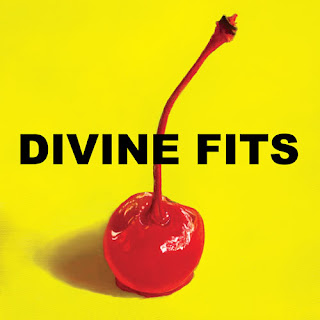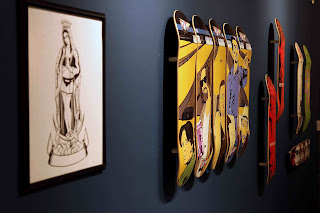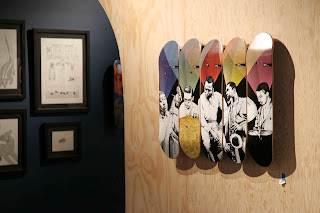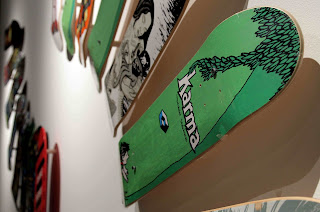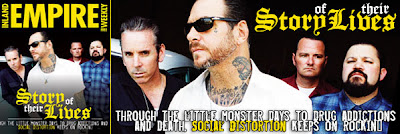When
a 21-year-old Mike Ness rolled up to his friend’s half pipe,
16-year-old Jonny Wickersham had no idea he was looking at his future
sitting on a stolen 10-speed.
The
lead singer of then up-and-coming punk band Social Distortion who was
five years Wickersham’s senior already had the sort of cult of
personality that announced his presence—even from behind a spray painted
black bicycle with flipped-up, handle bars.
The
two young men, who lived a block away from one another in the Costa
Mesa apartment clusters, bonded over their love of punk rock music,
skateboarding and general disenchantment with the world.
Wickersham
and his friends had recently witnessed Ness and company’s performance
in Pomona. “He thought of me more like a kid coming around, like super
fandom,” Wickersham says. As he got older though, the two became peers
in the music business, their Orange County-based bands sharing stages
and fans.
Wickersham,
now known as punk rock guitarist Jonny 2 Bags—who has done time in
Cadillac Tramps, Youth Brigade and U.S. Bombs—took over as guitarist for
Ness’ wildly popular, three decades-old punk rock institution. He got
the job after Ness’ friend and band co-founder, Dennis Danell, died on
Feb. 29, 2000, from a brain aneurysm.
More
recently, Wickersham and Ness are in the midst of more than a year of
touring to promote the band’s most successful album to date, 2011’s Hard
Times and Nursery Rhymes. Social Distortion stops in at the Fox Theater
in Pomona Friday and Saturday, February 17 and 18.
Somewhere Between Heaven and Hell
Hard
Times and Nursery Rhymes premiered on the Billboard charts at No. 4,
securing the band’s immediate future on the road. The Ness-produced
album, Social Distortion’s seventh studio recording four years in the
making, is the band’s first Top 10 showing.
“I
guess it was a critic’s record,” Ness says. “To get this kind of
recognition this late in the game is great.” The record’s success is due
in part to the chemistry between Ness and Wickersham, who share
songwriting duties on many of the tracks. Bassist Brent Harding and
drummer David Hidalgo Jr. currently round out the lineup.
Danell’s
death put the band’s future in question for many. Danell’s footprint on
the band was so huge, it meant very big shoes to fill, Wickersham says.
“Although
I wanted to do it, and I wanted to play in the band, it was such
horrible circumstances,” Wickersham says looking back. He himself a big
fan and close friend of Danell. “Like I was an imposter.”
Despite
having filled in for Danell in 1997 for part of the band’s European
tour, Wickersham’s next gig with Ness was possibly his most somber: a
benefit for Danell’s family at the former Irvine Meadows Amphitheater,
now the Verizon Wireless Amphitheater. Danell’s wife, Christy, helped
ease the load Wickersham carried.
“When
she got there, she walked up to me and said, ‘You must really feel like
you have the weight of the world on your shoulders today,’” Wickersham
recalls. “I mean, she’s grieving, and I couldn’t believe she thought
about how I would be feeling. That made me feel a lot better.”
A New Era
Not
long after, Ness asked Wickersham to join the band full time, and a new
working relationship was born, as well as a new era for Social
Distortion. The two immediately collaborated lyrically, a role in the
band Ness rarely shared with his oft-rotating players. Danell had been
the only constant besides Ness, and one of the few to share songwriting
duties with the band’s front man.
“It
felt really great,” Wickersham says about the confidence Ness showed.
The two started writing together for what turned into 2004’s Sex, Love
and Rock ‘n’ Roll. “The chemistry in that sense was really strong at
that time.”
Ness
had plenty of confidence in Wickersham. “He’s a guitar player, and he
grew up listening to this band,” Ness says. “We had chemistry. It’s a
rare thing. Some artists can collaborate with just anybody. For me there
has to be that level of comfort, trust and respect.”
The
two grew up in similar situations, hailing from broken homes and
finding solace in punk rock. “We understand each other,” Ness says,
adding that their long history together helped cement the bond.
Punk Lives On
A
decade later and the band shows no sign of slowing down; its audience
continuing to grow. With the support of its new label, Epitaph Records,
Ness opened up to trying new things to reach a bigger audience,
confident in the label’s authenticity while flirting with mainstream
success.
“We
kind of always had the mindset that there are hundreds of thousands of
Social Distortion fans who don’t know it yet,” Ness say. After years of
keeping a stronghold on the Southern California scene, and remaining a
go-to guy for punkers of all varieties, he’s finally breaking through,
becoming genuinely famous in other circles.
“When
there is someone who I have a relationship with outside of work that is
not a typical candidate to be a fan, or they read about it and got the
record and they really like it, that’s always cool to me,” Ness says.
“Even back in the day, I didn’t only want to play in front of punk
rockers. I wanted to get all kinds of people to hear it.”
Ness
and the band performed on television for the first time, hitting Jimmy
Kimmell Live! last year. Ness also wrote and starred in a conceptual
short film for the album’s first single, “Machine Gun Blues.”
The
song strayed from Ness’ tried and true songwriting routine, as he set
out to break from writing purely down-on-his-luck autobiographical
songs. “I got back into character writing,” Ness says, citing “Gimme the
Sweet and Lowdown” as another example. The song portrays someone giving
advice to another who is hitting rock bottom.
“That
could be about me, or some of my friends, but I wanted to remove myself
from the song even though I am still sort of writing about myself,”
Ness says. “I didn’t want to fall into any one style of writing. You
just don’t want to get stuck. I wanted heavy, I wanted fiction,
nonfiction, I wanted slow and I wanted fast. I was basically going back
to how I was writing a song back in 1980, when I wrote ‘1945.’”
“Machine
Gun Blues” tells the tale of a machine gun-toting, Roaring ’20s
gangster in over his head. “It’s the not-so-glamorous side of gangster
life,” Ness says. “He genuinely feels remorse, things just got out of
control. He’s not a psychopath.”
If
that song was about Ness in an abstract way, one might read into it
some repentance for past mistakes. Ness famously struggled with heroin
addiction in his early years, followed by jail time and rehab to get his
mind straight before releasing the band’s second album, 1988’s Prison
Bound, the follow up to 1983’s Mommy’s Little Monster.
Prison
Bound signaled a crossroads for the band, leaning equally on Johnny
Cash and Exile on Main Street-era Rolling Stones. By 1990, the eponymous
album Social Distortion went gold, producing the band’s trademark
singles “Story of My Life” and “Ball and Chain,” making Ness a bona fide
rockabilly and punk rock icon.
The
next two albums, 1992’s Somewhere Between Heaven and Hell and 1996’s
White Heat, White Trash kept the band touring steadily.
From Mommy’s Little Monster to Nursery Rhymes
Social Distortion never really required a new album to draw crowds, particularly in Southern California.
“Social
Distortion is a good example of a band that has really stayed true to
the sound,” Wickersham says. “Mike likes to evolve from record to record
but he doesn’t want to completely change the sound of the band. He
ignores trends.”
The
band consistently sells out House of Blues clubs for weeks at a
time—the fans’ enthusiasm always reminding the band of its relevance
between releases, motivating them to get back to writing songs.
“I
don’t care what anyone says, no matter how hot your band is, 50 percent
of the show is the crowd,” Ness says. “When you have that kind of
reaction, it inspires you to go in and do something to support that. We
definitely feed off of that.”
Each
time Ness returns to the studio, he’s armed with an arsenal of songs
chronicling his life, a sort of portrait of where he’s at emotionally.
No longer mommy’s little monster, he’s more your typical dad in many
respects, one who pays the bills with a vintage Gibson and a tour bus.
With that comes some grown up angst to boot.
His
sons, 20-year-old Julian and 16-year-old Johnny, along with his wife,
Christine, help keep Ness grounded and content. Julian, who has joined
his father on stage occasionally, is headed for the family biz.
“Julian
is the younger version of me,” Ness says. “We cause each other anxiety
because of that. Our relationship has gone through a lot of ups and
downs. But it’s in a good place.”
The
song “Writing on the Wall” was inspired by Ness’ experience on the
other side of drug abuse, as a father wondering if his son is lost in
the perils of addiction.
“To
have made it through that and be on the other side of it right now,
it’s just so nice to not have to worry about that,” Ness says. “You
still worry if they are going to be able to work and support themselves,
but to not have to worry about his safety is so nice.”
Julian
is making his father proud these days, playing guitar in the Orange
County band the Breakdowns. The band recently opened for the Cadillac
Tramps at the Tiki Bar in Costa Mesa.
Other
songs, like “Diamond in the Rough” give a glimpse of a happier, well
adjusted Ness looking at a wide-open future as he sings “I’ve got a
reason to live another day.”
“Through
the years I’ve learned to get inspiration from the positive things in
my life as well, not just the dark, negative, painful stuff,” says Ness,
who famously has the words “Love” and “Pain” tattooed on his knuckles.
“I think it’s important to balance it . . . I am different person than I
was in 1995. I am older. I am hopefully more mature, and hopefully a
little wiser.”
These
days, Ness is nearing 50, living on the Newport Beach Peninsula,
staying fit through a vegetarian diet and boxing in the ring with
Julian. Life is sweet, something a listen to Hard Times and Nursery
Rhymes reveals. He remains grounded.
“I
think that Social D has gotten successful very slowly over the last 33
years,” Ness reflects. “Our level of success has been very gradual and
very organic, a slow upward movement. It helps you appreciate the
success a little more, and it helps you keep it kind of real.”
Social
Distortion with Frank Turner and the Sleeping Souls, Sharks at the Fox
Theater, 301 S. Garey Ave., Pomona, (909) 865-3802; www.foxpomona.com.
Fri-Sat, Feb. 17-18. 8PM. $35.
To link to the original story, click here:

